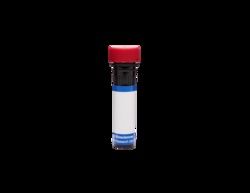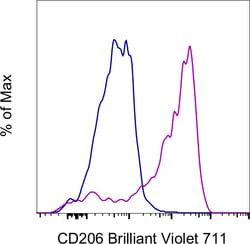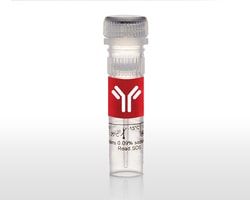200020014
CD284 (TLR4) Monoclonal Antibody (UT41), eBioscience™, Invitrogen™
Mouse Monoclonal Antibody
Manufacturer: Fischer Scientific
The price for this product is unavailable. Please request a quote
Antigen
CD284 (TLR4)
Concentration
0.5 mg/mL
Classification
Monoclonal
Form
Liquid
Regulatory Status
RUO
Gene Accession No.
Q9QUK6
Gene ID (Entrez)
21898
Isotype
IgG1 κ
Purification Method
Affinity chromatography
Gene
TLR4
Clone
UT41
Applications
Flow Cytometry
Conjugate
Unconjugated
Host Species
Mouse
Target Species
Mouse
Gene Alias
ARMD10; CD284; EGK_07381; homolog of Drosophila toll; hToll; lipopolysaccharide response; Lps; Ly87; Ran/M1; Rasl2-8; Tlr4; TLR-4; TOLL; toll like receptor 4; toll/interleukin-l receptor (TIR) domain; toll4; toll-like receptor 4; toll-like receptor 4 immunity-related protein; Toll-like receptor 4-like protein; Toll-like receptor4 protein
Gene Symbols
TLR4
Primary or Secondary
Primary
Product Type
Antibody
Description
- Description: The UT41 monoclonal antibody was generated against BaF3 cells overexpressing mouse TLR4
- So far, at least twelve members of the Toll family have been identified
- This family of type I transmembrane protein is characterized by an extracellular domain with leucine-rich repeats and a cytoplasmic domain with homology to the type I IL-1 receptor
- Two of these receptors, TLR2 and TLR4, are pattern recognition receptors and signaling molecules in response to bacterial lipoproteins and have been implicated in innate immunity and inflammation
- TLR4 physically associates with another molecule called MD-2, and together with CD14, this complex is responsible for LPS recognition and signaling
- TLR4, which is approximately 100 kDa, is expressed by myeloid lineage cells
- The MTS510 monoclonal antibody co-immunoprecipitates MD-2 (∽30 kDa) and TLR4 (∽100 kDa), and preferentially reacts with TLR4 that is associated with MD-2
- In comparison, binding of the UT41 monoclonal antibody occurs with and without formation of the TLR4/MD-2 complex
- Please contact eBioscience Technical Support for further information
- Applications Reported: This UT41 antibody has been reported for use in flow cytometric analysis
- Applications Tested: This UT41 antibody has been tested by flow cytometric analysis of mouse thioglycolate-elicited peritoneal exudate cells
- This can be used at less than or equal to 0.5 μg per test
- TLR4 is member of the Toll like receptor (TLR) family which plays a fundamental role in pathogen recognition and activation of innate immunity
- TLRs are highly conserved from Drosophila to humans and share structural and functional similarities
- This receptor is most abundantly expressed in placenta, and in myelomonocytic subpopulation of the leukocytes
- Mammalian cells respond to LPS by activating TLR4
- TLR4 belongs to the multi-protein complex of lipopolysaccharide (LPS) receptor, containing CD14, LY96 and TLR4, and is involved in signal transduction events induced by lipopolysaccharide (LPS) found in most gram-negative bacteria
- TLR4 aids in the recognition of pathogen-associated molecular patterns (PAMPs) that are expressed on infectious agents, and mediate the production of cytokines necessary for the development of effective immunity
- The various TLRs exhibit different patterns of expression
- Mutations in the TLR4 gene have been associated with differences in LPS responsiveness
- Also, several transcript variants of the TLR4 gene have been found, but the protein coding potential of most of them is uncertain
- TLR4 is expressed by peripheral blood monocytes and a small population of B-cells and is also expressed in human placenta
- Studies with TLR4-deficient mice indicate that the main ligand for TLR is lipopolysaccharide
- Consequently, these mice also showed increased susceptibility to Gram-negative sepsis.
Compare Similar Items
Show Difference
Antigen: CD284 (TLR4)
Concentration: 0.5 mg/mL
Classification: Monoclonal
Form: Liquid
Regulatory Status: RUO
Gene Accession No.: Q9QUK6
Gene ID (Entrez): 21898
Isotype: IgG1 κ
Purification Method: Affinity chromatography
Gene: TLR4
Clone: UT41
Applications: Flow Cytometry
Conjugate: Unconjugated
Host Species: Mouse
Target Species: Mouse
Gene Alias: ARMD10; CD284; EGK_07381; homolog of Drosophila toll; hToll; lipopolysaccharide response; Lps; Ly87; Ran/M1; Rasl2-8; Tlr4; TLR-4; TOLL; toll like receptor 4; toll/interleukin-l receptor (TIR) domain; toll4; toll-like receptor 4; toll-like receptor 4 immunity-related protein; Toll-like receptor 4-like protein; Toll-like receptor4 protein
Gene Symbols: TLR4
Primary or Secondary: Primary
Product Type: Antibody
Antigen:
CD284 (TLR4)
Concentration:
0.5 mg/mL
Classification:
Monoclonal
Form:
Liquid
Regulatory Status:
RUO
Gene Accession No.:
Q9QUK6
Gene ID (Entrez):
21898
Isotype:
IgG1 κ
Purification Method:
Affinity chromatography
Gene:
TLR4
Clone:
UT41
Applications:
Flow Cytometry
Conjugate:
Unconjugated
Host Species:
Mouse
Target Species:
Mouse
Gene Alias:
ARMD10; CD284; EGK_07381; homolog of Drosophila toll; hToll; lipopolysaccharide response; Lps; Ly87; Ran/M1; Rasl2-8; Tlr4; TLR-4; TOLL; toll like receptor 4; toll/interleukin-l receptor (TIR) domain; toll4; toll-like receptor 4; toll-like receptor 4 immunity-related protein; Toll-like receptor 4-like protein; Toll-like receptor4 protein
Gene Symbols:
TLR4
Primary or Secondary:
Primary
Product Type:
Antibody
Antigen: CD45.1
Concentration: 0.2 mg/mL
Classification: Monoclonal
Form: Liquid
Regulatory Status: RUO
Gene Accession No.: P06800
Gene ID (Entrez): 19264
Isotype: IgG2a κ
Purification Method: Affinity chromatography
Gene: Ptprc
Clone: A20
Applications: Flow Cytometry
Conjugate: Brilliant Violet 650
Host Species: Mouse
Target Species: Mouse
Gene Alias: B220, Cd45, CD45 antigen, CD45R, GP180, Lca, L-CA, Leukocyte common antigen, loc, LY5, Ly-5, Lymphocyte antigen 5, lymphocyte common antigen, Lyt-4, protein tyrosine phosphatase, receptor type C, protein tyrosine phosphatase, receptor type, C, protein tyrosine phosphatase, receptor type, c polypeptide, PTPRC, Receptor-type tyrosine-protein phosphatase C, RT7, T200, T200 glycoprotein, T200 leukocyte common antigen
Gene Symbols: Ptprc
Primary or Secondary: Primary
Product Type: __
Antigen:
CD45.1
Concentration:
0.2 mg/mL
Classification:
Monoclonal
Form:
Liquid
Regulatory Status:
RUO
Gene Accession No.:
P06800
Gene ID (Entrez):
19264
Isotype:
IgG2a κ
Purification Method:
Affinity chromatography
Gene:
Ptprc
Clone:
A20
Applications:
Flow Cytometry
Conjugate:
Brilliant Violet 650
Host Species:
Mouse
Target Species:
Mouse
Gene Alias:
B220, Cd45, CD45 antigen, CD45R, GP180, Lca, L-CA, Leukocyte common antigen, loc, LY5, Ly-5, Lymphocyte antigen 5, lymphocyte common antigen, Lyt-4, protein tyrosine phosphatase, receptor type C, protein tyrosine phosphatase, receptor type, C, protein tyrosine phosphatase, receptor type, c polypeptide, PTPRC, Receptor-type tyrosine-protein phosphatase C, RT7, T200, T200 glycoprotein, T200 leukocyte common antigen
Gene Symbols:
Ptprc
Primary or Secondary:
Primary
Product Type:
__
Antigen: CD45.1
Concentration: 0.2 mg/mL
Classification: Monoclonal
Form: Liquid
Regulatory Status: RUO
Gene Accession No.: P06800
Gene ID (Entrez): 19264
Isotype: IgG2a κ
Purification Method: Affinity chromatography
Gene: Ptprc
Clone: A20
Applications: Flow Cytometry
Conjugate: Brilliant Violet 650
Host Species: Mouse
Target Species: Mouse
Gene Alias: B220, Cd45, CD45 antigen, CD45R, GP180, Lca, L-CA, Leukocyte common antigen, loc, LY5, Ly-5, Lymphocyte antigen 5, lymphocyte common antigen, Lyt-4, protein tyrosine phosphatase, receptor type C, protein tyrosine phosphatase, receptor type, C, protein tyrosine phosphatase, receptor type, c polypeptide, PTPRC, Receptor-type tyrosine-protein phosphatase C, RT7, T200, T200 glycoprotein, T200 leukocyte common antigen
Gene Symbols: Ptprc
Primary or Secondary: Primary
Product Type: __
Antigen:
CD45.1
Concentration:
0.2 mg/mL
Classification:
Monoclonal
Form:
Liquid
Regulatory Status:
RUO
Gene Accession No.:
P06800
Gene ID (Entrez):
19264
Isotype:
IgG2a κ
Purification Method:
Affinity chromatography
Gene:
Ptprc
Clone:
A20
Applications:
Flow Cytometry
Conjugate:
Brilliant Violet 650
Host Species:
Mouse
Target Species:
Mouse
Gene Alias:
B220, Cd45, CD45 antigen, CD45R, GP180, Lca, L-CA, Leukocyte common antigen, loc, LY5, Ly-5, Lymphocyte antigen 5, lymphocyte common antigen, Lyt-4, protein tyrosine phosphatase, receptor type C, protein tyrosine phosphatase, receptor type, C, protein tyrosine phosphatase, receptor type, c polypeptide, PTPRC, Receptor-type tyrosine-protein phosphatase C, RT7, T200, T200 glycoprotein, T200 leukocyte common antigen
Gene Symbols:
Ptprc
Primary or Secondary:
Primary
Product Type:
__
Antigen: CD206 (MMR)
Concentration: 5 μL/Test
Classification: Monoclonal
Form: Liquid
Regulatory Status: RUO
Gene Accession No.: P22897
Gene ID (Entrez): 4360
Isotype: IgG1 κ
Purification Method: Affinity chromatography
Gene: Mrc1
Clone: 19.2
Applications: Flow Cytometry
Conjugate: Brilliant Violet 711
Host Species: Mouse
Target Species: Human
Gene Alias: AW259686; bA541I19.1; CD206; CELE_Y39A3CR.4; CLEC13D; CLEC13DL; C-type lectin domain family 13 member D; C-type lectin domain family 13 member D-like; ddp-1; hMR; Human mannose receptor; macrophage mannose receptor 1; Macrophage mannose receptor 1-like protein 1; mannose receptor, C type 1; mannose receptor, C type 1-like 1; Mitochondrial import inner membrane translocase subunit Tim8; MMR; MR; MRC1; MRC1L1; tim-8; Y39A3CR.4
Gene Symbols: Mrc1
Primary or Secondary: Primary
Product Type: __
Antigen:
CD206 (MMR)
Concentration:
5 μL/Test
Classification:
Monoclonal
Form:
Liquid
Regulatory Status:
RUO
Gene Accession No.:
P22897
Gene ID (Entrez):
4360
Isotype:
IgG1 κ
Purification Method:
Affinity chromatography
Gene:
Mrc1
Clone:
19.2
Applications:
Flow Cytometry
Conjugate:
Brilliant Violet 711
Host Species:
Mouse
Target Species:
Human
Gene Alias:
AW259686; bA541I19.1; CD206; CELE_Y39A3CR.4; CLEC13D; CLEC13DL; C-type lectin domain family 13 member D; C-type lectin domain family 13 member D-like; ddp-1; hMR; Human mannose receptor; macrophage mannose receptor 1; Macrophage mannose receptor 1-like protein 1; mannose receptor, C type 1; mannose receptor, C type 1-like 1; Mitochondrial import inner membrane translocase subunit Tim8; MMR; MR; MRC1; MRC1L1; tim-8; Y39A3CR.4
Gene Symbols:
Mrc1
Primary or Secondary:
Primary
Product Type:
__






